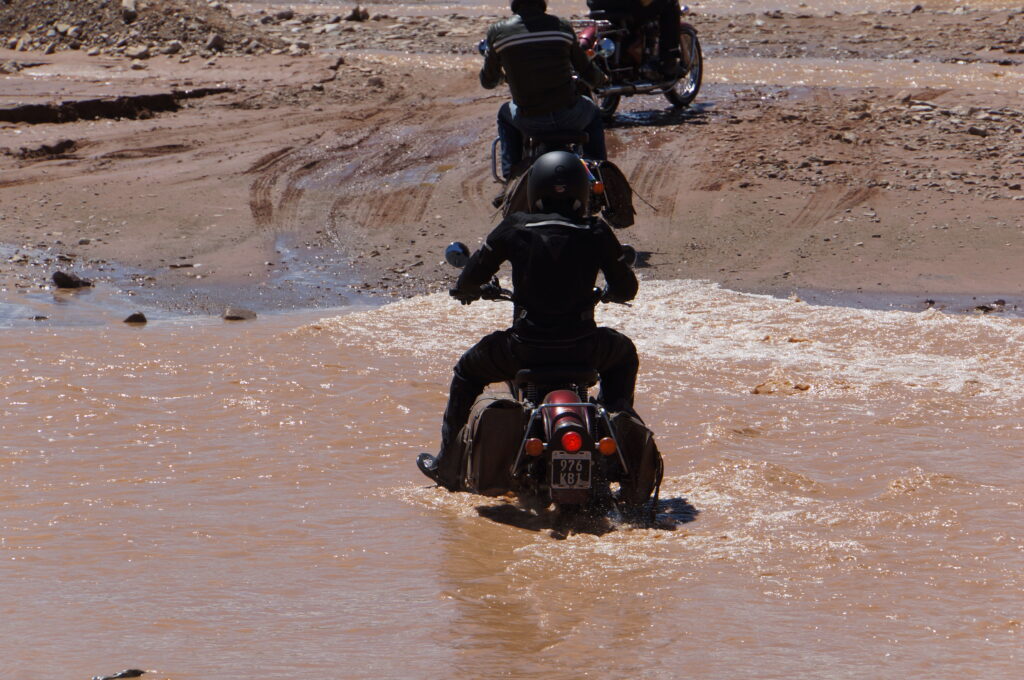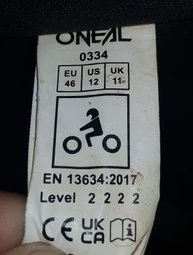The first few times I had to buy motorcycle gear, I was completely lost. There are endless standards to wade through and salespeople who might not know their elbow from their exhaust pipe. Whether it was jackets, helmets, gloves, or boots, I don’t think I nailed it right the first time on any of them ! So, I decided to put together a series of articles to help fellow riders cut through the BS. Today’s focus : boots !

The European standards for motorcycle boots come from the Personal Protective Equipment (PPE) Regulation (EU) 2016/425. These rules set the bar for the protective gear that bikers need. Basically, they make sure your boots can handle the tough stuff you face on the road. Here’s a breakdown of the key European standards you need to know about for motorcycle boots.
What are the official texts ?
All you always wanted to know and never dared to ask comes back to EN 13634:2017.
This is the primary standard for motorcycle boots, specifying the requirements and test methods for protective footwear. The standard evaluates boots on several criteria, including :
Height
Impact Abrasion Resistance
Impact Cut Resistance
Boots must provide sufficient coverage, generally at least 16 cm above the footbed for the lower leg and ankle protection.
The boots’ ability to withstand abrasion in case of a slide.
The boots’ resistance to cuts from sharp objects.
Transverse Rigidity
Permeability and Water Absorption
Rigidity of the Boot Upper
The ability of the sole to withstand deformation and provide support.
Ensuring the boots offer some degree of waterproofing or water resistance.
Ensuring the upper part of the boot provides protection and does not easily collapse.
Height
Boots must provide sufficient coverage, generally at least 16 cm above the footbed for the lower leg and ankle protection.
Impact Abrasion Resistance
The boot’s ability to whistand abrasion in case of a slide.
Impact Cut Resistance
The boot’s resistance to cuts from sharp objects.
Transverse Rigidity
The ability of the sole to withstand deformation and provide support.
Permeability & Water Absorption
Ensuring the boots offer some degree of waterproofing or water resistance.
Rigidity of the Boot Upper
Ensuring the upper part of the boot provides protection and does not easily collapse.
Where are the tests conducted ?
Certification of motorcycle boots according to the European standards EN 13634:2017 is conducted by notified bodies. These are organizations designated by an EU country to assess the conformity of certain products before being placed on the market. Notified bodies are accredited to ensure that products meet the essential health and safety requirements set out in the EU regulations.
For example (click on the name for more info) :
SATRA Technology Centre – United Kingdom (still Europe ? … that’s a whole other debate !)
TÜV Rheinland – Germany
RICOTEST – Italy
SGS – Switzerland
CENTEXBEL – Belgium
So, basically the manufacturer submits an application for certification to a notified body. The notified body then conducts rigorous testing according to the EN 13634:2017 standard, evaluating all necessary aspects such as impact abrasion resistance, cut resistance, and water resistance. They will then notify the test results to determine if the boots meet the necessary safety requirements. If the boots pass the tests, the notified body issues a certificate of conformity, allowing the manufacturer to mark the product with the CE label.
By obtaining certification from these recognized notified bodies, manufacturers ensure that their motorcycle boots meet the stringent safety standards required for sale within the European market.
How are the tests conducted ?


Each test evaluates specific aspects of the boot’s protective capabilities. The results are then classified into two performance levels :
Level 1 : Indicates that the boot meets the basic requirements for safety and protection. Suitable for general road use.
Level 2 : Indicates that the boot exceeds the basic requirements and offers enhanced protection. Recommended for more demanding conditions and professional use.
The overall rating of the boot depends on its performance in these individual tests. A boot must meet or exceed the criteria for Level 1 in all tests to be certified at Level 1. To achieve Level 2 certification, the boot must meet or exceed the criteria for Level 2 in all relevant tests.
In details :
Ankle Impact Protection Test
Method : A weighted pendulum impacts the ankle area of the boot. The force transmitted to the inside of the boot is measured.
Performance Levels :
Level 1 : Transmitted force must be less than 35 kN.
Level 2 : Transmitted force must be less than 25 kN.
Rigidity of the Boot Upper Test
Method : The boot upper is subjected to a force to test its structural integrity and resistance to collapse.
Performance Levels :
Level 1 : The upper must maintain its shape under a specified force.
Level 2 : The upper must maintain its shape under a higher specified force.
Water Penetration and Absorption Test
Method : The boot is partially submerged in water for a specified duration. The amount of water absorbed by the boot is measured.
Performance Levels :
Level 1 : Absorption of less than 30% of the boot’s weight.
Level 2 : Absorption of less than 20% of the boot’s weight.
Transverse Rigidity Test
Method : A force is applied to the boot sole to test its rigidity. The amount of deformation is measured to assess the sole’s strength.
Performance Levels :
Level 1 : The sole must withstand a force of 1,000 Newtons with minimal deformation.
Level 2 : The sole must withstand a force of 1,500 Newtons with minimal deformation.
Impact Cut Resistance Test
Method : A blade is dropped onto the boot material with a specified force. The depth of the cut is measured to determine the material’s cut resistance.
Performance Levels :
Level 1 : Maximum cut depth of 25 mm.
Level 2 : Maximum cut depth of 15 mm.
Impact Abrasion Resistance Test
Method : A sample of the boot material is subjected to abrasion using a rotating drum covered with abrasive paper. The test measures the time it takes for a hole to form in the material.
Performance Levels :
Level 1 : Minimum of 5 seconds of abrasion resistance.
Level 2 : Minimum of 12 seconds of abrasion resistance.
How can I find the information ?
All the necessary information are then written on the label. It should look something like this :

Mandatory Information to be Certified as Protective Equipment :
Mandatory Information to be Certified as Protective Equipment :
From left to right, the 2 – 2 – 2 – 2 correspond to the results this boots got through the tests in this specific order :
_ Minimal height : level 2 means the boot is at least 16.2cm high for sizes less than 36 and at least 19.2cm high for sizes more than 45.
_ Impact Abrasion Resistance : minimum of 12 seconds
_ Impact Cut Resistance : maximum cut depth of 15mm.
_ Transverse Rigidity : minimal deformation when 1,500 Newtons are applied.
Additional Information :
As you see, it basically comes down to only four tests to be certified as a motorcycle boot. So sometimes manufacturers will throw in some other tests and you might find labels with the following norms :
_ PA (Protective Ankle) : This indicates that the boots have additional protective features specifically designed to protect the ankle area.
_ IPS (Impact Protection for Shin) : This denotes that the boots include impact protection for the shin area.
_ FO (Fuel Oil Resistant) : This indicates that the boots’ soles are resistant to damage and degradation caused by contact with fuel oil.
_ WR (Water Resistant) : This means the boots are designed to resist water penetration, see the tests we explained earlier on.
_ WAD (Waterproof and Breathable) : This means the boots are designed to be fully waterproof while also allowing moisture from sweat to escape, helping to keep the feet dry and comfortable.
_ SRA/B/C (Slip Resistance Rating) :
SRA : The sole has been tested for slip resistance on ceramic tile floors covered with a dilute soap solution.
SRB : The sole has been tested for slip resistance on steel floors covered with glycerol.
SRC : The sole has been tested for slip resistance on both surfaces mentioned above (SRA + SRB), indicating the highest level of slip resistance.
Is this really usefull ?
Okay, here is something for you to keep in mind. Let’s take a look at the non-mandatory Ankle Impact Protection test : the boot should transmit to your ankle a force less than 35 kN, right ? Well, here is the interesting part : studies on fractures have shown that …
_ Lateral Malleolus (part of the fibula) : Fractures can occur with forces in the range of 4 to 10 kN, depending on the angle and direction of the force.
_ Medial Malleolus (part of the tibia) : Fractures can occur with slightly higher forces, often between 5 to 15 kN.
Basically ankle bones can typically withstand forces of up to 8-12 kN before fracturing. This range can vary based on age, bone density, and health of the individual. But my point is, if the boot transmits to my ankle a 25 kN force, it will still be rated level 2 while my bones will be smashed to pieces !
While certifications like EN 13634:2017 give you a baseline for protection, some of us riders see them as kind of useless. Real-world crashes are messy and don’t follow the script of standardized tests. Plus, not all brands play by the same rules, and sometimes those certified boots are more about ticking boxes than actual road performance, comfort, and durability. So, while these certifications are a good start, don’t let them be the only thing you look at. Make sure to factor in fit, comfort, and what other riders are saying before you make your pick.
